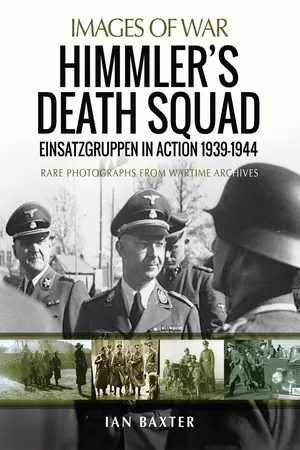
Himmler's Death Squad - Einsatzgruppen in Action, 1939–1944
Rare Photographs from Wartime Archives
- 136 pages
- English
- ePUB (mobile friendly)
- Available on iOS & Android
Himmler's Death Squad - Einsatzgruppen in Action, 1939–1944
Rare Photographs from Wartime Archives
About this book
The murderous activities of Himmler’s Einsatzgruppen – or death squads – rank high among the horrors of the Nazi regime during the Second World War. These hand-picked groups followed in the wake of Waffen-SS and Wehrmacht units advancing intro Eastern Europe and Soviet Russia. Their mass murder of civilians in the occupied territories will never be accurately quantified but is likely to have exceeded two million people, including some 1.3 million of the 6, 000, 00 Jews who perished in the Holocaust. The graphic and shocking photographs in this Images of War book not only show the hunt for and rounding up of civilians, communists, Jews and Romani people but the active support given to the Einsatzgruppen by SS units and Wehrmacht units. The latter strenuously denied any collusion but the photographic evidence here refutes this.
Frequently asked questions
- Essential is ideal for learners and professionals who enjoy exploring a wide range of subjects. Access the Essential Library with 800,000+ trusted titles and best-sellers across business, personal growth, and the humanities. Includes unlimited reading time and Standard Read Aloud voice.
- Complete: Perfect for advanced learners and researchers needing full, unrestricted access. Unlock 1.4M+ books across hundreds of subjects, including academic and specialized titles. The Complete Plan also includes advanced features like Premium Read Aloud and Research Assistant.
Please note we cannot support devices running on iOS 13 and Android 7 or earlier. Learn more about using the app.
Information
Chapter One
Murder in Poland
Table of contents
- Cover
- Title
- Copyright
- Contents
- About the Author
- Introduction
- Formation
- Chapter One: Murder in Poland
- Chapter Two: Murder in Russia
- Chapter Three: Murder in the Baltic States
- Chapter Four: Last Years
- Epilogue
- Appendix 1: Structure of the Reich Main Security Office
- Appendix 2: Einsatzgruppen operations in Poland
- Appendix 3: Einsatzgruppen task force on the Eastern Front
- Appendix 4: Number of people killed by the Einsatzgruppen
- Appendix 5: German Police Battalions and Regiments, 1939–44
- Appendix 6: Executions carried out by Einsatzkommando 3